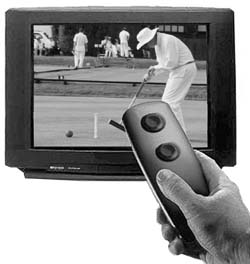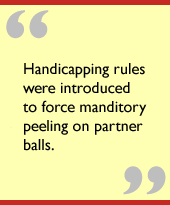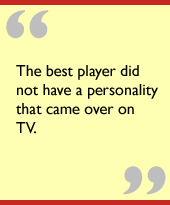

|
Back to |
| The Front Page |
| Letters & Opinion |
|
Croquet on TV - its spotty history and uncertain future
by James Hawkins editor, The Croquet Gazette |
|
||||||
I'd like to think that croquet will become the next big television sensation. Maybe we'll see the World Champion, £500,000 cheque in hand, posing for the cameras as he kisses the winner's trophy. And maybe I'll be sat in the studio, chatting with Gary Lineker about Rob and Reg's stroke technique. Clubs will be inundated with new members, and the future of the game will be assured.
The author, editor of The Croquet Gazette, has made himself something of an authority on the public reputation of croquet as created by and reflected in popular images of the sport. He chronicles three opportunities to promote croquet in England via television over the last two decades and in hindsight analyzes some of the miscalculations of the televisions producers and the Croquet Association elite. Some would argue that the biggest error was not putting Golf Croquet front and center in these television forays - but in fairness to the British croquet bigwigs of the time, Golf Croquet's time had not yet come. With the recent popular emergence of Golf Croquet, promoters can now profit from the lessons of British croquet history in the 1980's. The Americans have not yet created equivalent opportunities for a media breakthrough, but when a complete croquet match is televised nationally in America in the 21st Century, it's a pretty good bet that the game will be Golf Croquet.
Wishful thinking for sure - but those who might herald croquet as the TV game of the future should first look at the sport's past dalliances with the medium.
Short Croquet in the 80's

|
David Plowright, then the Managing Director of Granada Television, was a keen garden croquet player. Heading the project from the CA's end was Chris Hudson, then the full-time National Development Officer [and later the Executive Secretary of the World Croquet Federation}. The idea of the competition was very much Plowright's personal crusade, and a short croquet lawn was laid at Granada's Manchester Studios.
One of the main stumbling blocks to the broadcasting of croquet is the dimensions of the court. Snooker was popularised (in the UK at any rate) because of the advent of colour television; the colours look fine on screen, the table fits well into the dimensions of a television set, games finish within 30 minutes, directors can get away with filming using just three cameras, and - vitally - it never rains.
By comparison, cramming a croquet lawn on to a TV screen would be like showing a snooker match played with marbles - the balls would be just too small for viewers to see. The play happens outside, which is both expensive and, on a rainy day, miserable. What's more, games are long, drawn-out, frequently one-sided and often boring.
Snooker is not short of climaxes, providing interest with the potting of each difficult ball. An expert croquet player can manoeuvre himself so there is never a difficult shot. So where's the tension?

The CA's solution came with the invention of Short Croquet. Shrink the playing area down to half size, cut the game down to six-hoops-and-the-peg, and put on a time limit. To toughen the game up, handicapping rules were introduced to force mandatory peeling on partner balls.
The twelve players who took part in the Granada event were selected as representatives from England, Ireland, Scotland and Wales. They battled among themselves in blocks of three, before playing off for a single winner. The week before, players had met at Cheltenham for a briefing. The Irish were absent, and played more defensively than a demonstration tournament required. Each of their games went to time. Indeed, the imposition of the compulsory peeling rule left many players struggling beyond their own capabilities, and made for a defensive spectacle throughout.
Martin Murray (for Scotland) tried his best to heat things up, by attempting to peg out with a jump shot over Hoop 6. Eventually, both the Welsh and Scottish blocks gave a three-way tie, and were reduced to an unedifying penalty shoot-out at the peg.
Three days of rain-soaked play saw the dream pairing for the final: Nigel Aspinall (the top seed) against the rising young star of the future, the 20-year old David Peterson. To little surprise, Peterson scored just two hoops, and Aspinall sailed home to win. Under the CA's strict rules on professionalism, Aspinall could keep only £25 of the £150 prize money from the Royal Bank of Scotland. The balance was donated back to the CA.
Looking back now, Andrew Hope, who represented Scotland, highlights a major problem. "Nigel was the best player, but like the vast majority of us, did not have a personality that came over on TV."

As a young viewer in my first season of play, it'd be difficult to disagree. Sixteen years on, my only clear memory is a characteristically extrovert interview between Richard Hilditch and the programme's anchorman, Elton Welsby. Hilditch is perhaps the most positive of the event's veterans: "Overall, I was proud to have taken part. The TV company did a very good job, with serious coverage which didn't patronise at all. Live coverage was a mistake, but the evening highlights programme was much better, and showed that a reasonable job could be done." Sadly, the highlights of the final went out 45 minutes late after the UEFA Cup Final overran (Steaua Bucharest's boring win on penalties over Barcelona could hardly have fired up the viewers ready for croquet).
Even so, viewing figures weren't disastrous. Average audience over 11 programmes was 189,000 homes, or 285,000 individuals. This peaked with the Wednesday 5.15 programme edging towards half a million. Audience share averaged 33% of homes, peaking during the Thursday afternoon broadcast, with 61% of households.
The national press found enough material to sustain themselves for a week or so. Good natured though much of it was (including one piece by an rising young journalist named Alastair Campbell, now the shadowy Director of Communications for British Prime Minister, Tony Blair) none of the items seemed able to shed the writers' preconceptions. As the Daily Telegraph put it, "It is difficult to dispel visions of lazy days pottering about on the vicar's lawn."
Both the viewing figures and the post-transmission feedback probably came as some relief to Granada's executives. With a 35-strong crew and seven cameras, costs must have been huge. And yet, noises were made about repeating the event subsequently. Once David Plowright, as the project's driving force, retired, this idea was shelved. The purpose-built lawn was never used again.
Indoor speed croquet is easier to produce
This was not the last time British audiences were to see televised croquet. Five years later, Yorkshire Television tried again. This time the problem of an oversized lawn was solved by going indoors. A lightning-fast indoor carpet was laid out in a sports centre in Doncaster. Compulsory peeling had failed to find much favour in Manchester (being both confusing for viewers and too hard for most of the players). Here the game was speed croquet, with giant chess clocks rationing out the time to the two players.
The selection of competitors was interesting. John Walters, veteran of the Granada programme and now a surprise World Champion, was back. Test players Mark Saurin and Stephen Mulliner provided some hyperactive spectacle, and Debbie Cornelius showed that the game could suit both sexes.
Despite a better format, the broadcast was perhaps less successful. Being more of a demonstration match than a competitive event, many viewers were left wondering what was the point. Playing technique on an indoor carpet differs greatly from grass, and Walters adjusted least well to the indoor hoops. Failing several hoops before running out of time, it must have puzzled audiences to see a World Champion sink to such ungraceful defeat.
Audience share amounted to something like 25% for a Saturday afternoon. It's questionable how good this was. Long before the launch of Channel 5 and Sky, only BBC1 could have been expected to provide much serious competition to Yorkshire's coverage. Needless to say, this pilot programme was never repeated.
Since then, there has been little interest in the game from networks other than the independent regional broadcasters. It's been impossible to detect whether coverage has produced much of an upturn in club recruitment. Back in the mid-80's, Granadaland had few CA-affiliated clubs. Only Bowdon saw much of an increase in membership. Much of that increase came, not from the viewing public, but from TV employees using the Granada plot during lunchbreaks. The construction of the Granada Studios theme-park (now defunct) subsequently left them with no daytime practice court, and their interest dwindled. As for Yorkshire TV, the broadcaster's catchment area consisted largely of a croquet desert. With few clubs in the region, there seems to have been no interest at all from viewers taking up the game at a club level.
Assessing the CA's forays into televising the game to date, it is difficult to see many beneficiaries. While screenings may have challenged the idea of a class-ridden and elitist game, some viewers must surely have gone away with the new preconception of a game of inpenetrable complexity. And those who did find a renewed enthusiasm for the game did so not through their nearby club, but by causing an upsurge in sales of garden croquet sets.
Golf Croquet's time has come
A decade later, a few people still hold out some hope of growing the game by attracting TV cameras. Egyptian television shows live coverage of Golf Croquet championships. Maybe, say the cynics, this is just flag-waving national pride. Golf Croquet is their national sport. It's the only sport at which they can boast a World Champion. But, let's face it, it's a heck of a lot easier to explain what's going on.
Bob Alman at Florida's National Croquet Center has been courting the County Film and Television Commissioner. "The big problem is what the camera has to see and show in order to give the viewer a sensible overview of what is actually happening. In Golf Croquet, it's not all that difficult, and I think it can be done. I believe it'd be possible to show an entire Golf Croquet game that people unacquainted with the sport could understand and enjoy. The challenge is getting access to the right producer and production team to convince them it's worth doing."
Liz Williams from Dyffryn Croquet Club is an acknowledged expert in sport and public relations, and remains sceptical. "Every couple of years I can get TV to come along to Dyffryn because I have enough of a newsworthy story to sell. I don't think that croquet, even in its Golf form, will feature heavily on sports [rather than news] programmes - you'd need a lot of camera crews to show it properly, and they're expensive."
For the sake of shareholders, networks tend to pick sports to satisfy the revenue from advertisers. Many of the middle-class, middle-aged viewers who might be attracted to croquet are at the same time relatively impervious to on-screen advertising.
Satellite broadcasters have spent fortunes on deals for major sporting events. A successful policy has accounted for much of the recent growth in Sky's viewing share. On the reverse side, the fees paid by ITV Digital to the Football League for such gloomy audience figures have led in no small part to the network's downfall. With Granada and Carlton so badly wounded by the venture's collapse, it's hard to see them or any other UK broadcaster taking any chance on a minority sport such as ours.
Brian Storey, croquet player turned UK Ice Hockey administrator, seems cynical about televised sport. He argues that minor sports - in Britain this includes most pursuits other than football (soccer) - pay to subsidise the massive TV output of the national game. Sky TV (the UK's multi-channel satellite broadcaster) pays in excess of £350,000,000 for Premiere League Football rights. Broadcasters are unwilling to take a risk on minor sports, be they ice hockey (a tiny sport in the UK) or croquet. If a sporting organisation wants coverage, they have to pay for it. Current fees equate to around £45,000 per hour, equivalent to a prohibitive $1,000 a minute. If for no other reason than financial, TV coverage with a major broadcaster would seem to be well beyond the reaches of croquet.
Many sports - netball, hockey, archery and the rest - cope without TV coverage. The Badminton Horse trials is one of the world's best attended events, with 250,000 people present. In 2002 it got one hour's television coverage. What chance, then, does croquet have?
This article is based on a similar article in The Croquet Gazette and is published here by permission of the author. Look for another article soon recounting others' recollections of televised croquet in Britain.